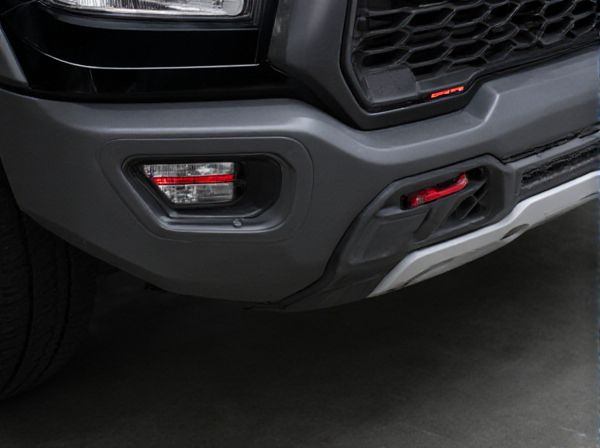
Photo illustration: Aerodynamic bumper vs Off-road bumper
Aerodynamic bumpers are designed to reduce air resistance, improving fuel efficiency and enhancing vehicle speed by promoting smooth airflow. Off-road bumpers prioritize durability and protection, featuring reinforced materials and designs that shield your vehicle against rough terrains and obstacles. Choosing the right bumper depends on whether you value streamlined performance or rugged defense for your driving needs.
Table of Comparison
| Feature | Aerodynamic Bumper | Off-Road Bumper |
|---|---|---|
| Design | Streamlined, reduces drag for better fuel efficiency | Robust, reinforced for maximum protection |
| Material | Lightweight composites or plastic | Heavy-duty steel or aluminum alloy |
| Function | Improves vehicle aerodynamics and speed | Protects against impacts and rough terrain |
| Weight | Low, enhances vehicle performance | High, adds durability but reduces fuel efficiency |
| Cost | Moderate, designed for everyday driving | High, specialized for off-road use |
| Best Use | Urban and highway driving | Off-road and rugged environments |
Introduction to Aerodynamic and Off-road Bumpers
Aerodynamic bumpers are designed to reduce air resistance and enhance fuel efficiency by streamlining the vehicle's front profile. Off-road bumpers prioritize durability and protection, constructed with heavy-duty materials to withstand impacts and rough terrain. Both bumper types serve specific purposes: aerodynamic bumpers optimize performance and speed, while off-road bumpers offer ruggedness and safety for extreme environments.
Design Differences: Streamlined vs Rugged
Aerodynamic bumpers feature a streamlined design with smooth curves and minimal protrusions to reduce wind resistance and improve fuel efficiency, ideal for on-road driving. Off-road bumpers exhibit a rugged construction with reinforced steel, aggressive angles, and integrated recovery points to withstand harsh terrain and impacts. The contrasting design priorities highlight performance optimization for aerodynamics versus durability and protection in off-road conditions.
Material Composition and Durability
Aerodynamic bumpers are typically made from lightweight materials such as ABS plastic or carbon fiber composites, designed to minimize air resistance and enhance fuel efficiency, offering moderate durability suitable for everyday driving conditions. Off-road bumpers are constructed from heavy-duty steel or reinforced aluminum alloys, engineered to withstand impacts, resist corrosion, and provide maximum protection during rugged terrain navigation. The durability of off-road bumpers significantly surpasses that of aerodynamic bumpers due to their robust material composition and reinforcement, making them ideal for harsh environments and off-road challenges.
Performance Impact on Vehicles
Aerodynamic bumpers enhance vehicle performance by reducing drag and improving fuel efficiency, especially at high speeds, making them ideal for highway driving. Off-road bumpers prioritize durability and protection against obstacles, which increases vehicle weight and may reduce overall speed and fuel economy. Choosing between the two affects handling characteristics, with aerodynamic bumpers favoring smooth airflow and off-road bumpers offering robustness and off-road capability.
Fuel Efficiency: Aerodynamic Advantage
Aerodynamic bumpers enhance fuel efficiency by reducing drag and improving airflow around the vehicle, leading to lower fuel consumption during highway driving. Off-road bumpers, designed for durability and protection, often increase wind resistance due to their bulky and angular shapes, which can negatively impact fuel economy. Choosing an aerodynamic bumper supports optimized vehicle performance and better mileage by minimizing aerodynamic drag compared to off-road alternatives.
Ground Clearance and Off-road Capability
Aerodynamic bumpers prioritize sleek design and reduced drag, often resulting in lower ground clearance that limits extreme off-road capability. Off-road bumpers are engineered with reinforced materials and increased ground clearance, allowing for better approach angles and enhanced obstacle clearance on rugged terrain. The higher clearance and robust construction of off-road bumpers significantly improve a vehicle's performance in challenging off-road conditions compared to aerodynamic models.
Safety Features Comparison
Aerodynamic bumpers are engineered to reduce drag while incorporating safety features such as energy-absorbing materials and deformation zones designed to minimize pedestrian injury during collisions. Off-road bumpers prioritize heavy-duty protection with reinforced steel construction, skid plates, and bull bars that safeguard vehicle components from rocks, debris, and impacts during off-road driving. While aerodynamic bumpers excel in pedestrian safety and fuel efficiency, off-road bumpers provide superior impact resistance and durability in rugged environments.
Aesthetic Appeal and Customization Options
Aerodynamic bumpers offer sleek, streamlined designs that enhance vehicle aesthetics by reducing drag and promoting a modern, sporty look, ideal for street performance enthusiasts. Off-road bumpers prioritize rugged, robust construction with customizable features like winch mounts, D-ring shackles, and light bar options, appealing to those who favor a tough, utilitarian style. Customization options for aerodynamic bumpers usually focus on paint finishes and subtle styling elements, while off-road bumpers provide extensive modularity for functional upgrades and personalized rugged aesthetics.
Cost Considerations and Maintenance
Aerodynamic bumpers typically cost less upfront due to simpler designs focused on reducing drag, while off-road bumpers often involve higher expenses from heavy-duty materials and reinforcement for rugged use. Maintenance costs for aerodynamic bumpers are generally lower, as they experience less physical impact and require minimal repairs, whereas off-road bumpers may need frequent inspections and repairs after exposure to rough terrain and potential damage. Choosing between these bumpers depends on budget priorities and intended vehicle use, balancing purchase price with long-term upkeep demands.
Choosing the Right Bumper for Your Needs
Aerodynamic bumpers enhance fuel efficiency and reduce wind noise, making them ideal for daily commuting and highway driving, whereas off-road bumpers provide superior durability and protection against rough terrains and obstacles, perfect for rugged outdoor adventures. Selecting the right bumper depends on your primary driving environment and priorities, such as prioritizing fuel economy or maximizing vehicle protection. Evaluate factors like material strength, design features, and compatibility with your vehicle to ensure the best fit for your needs.
 caratoz.com
caratoz.com